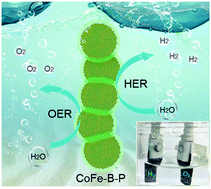Facile synthesis of Co–Fe–B–P nanochains as an efficient bifunctional electrocatalyst for overall water-splitting†
Abstract
Design of cost-effective bifunctional electrocatalysts for both the oxygen evolution reaction (OER) and hydrogen evolution reaction (HER) is vital for developing hydrogen energy for the future. Herein, a cost-effective phosphorus-doped Co–Fe–B material with chain-like structure (denoted as Co1–Fe1–B–P) is reported as an efficient and novel bifunctional electrocatalyst for the OER and HER, and was produced via a facile water-bath synthesis and subsequent phosphorization. For the OER, the as-prepared Co1–Fe1–B–P nanochains require an extremely low overpotential of about 225 mV at 10 mA cm−2 and possess a small Tafel slope of 40 mV dec−1 in alkaline media. Impressively, the HER properties of Co1–Fe1–B–P nanochains are superior to those of P-free Co–Fe–B in terms of overpotential at 10 mA cm−2 (173 mV vs. 239 mV) and kinetic Tafel slope (96 mV dec−1vs. 105 mV dec−1). The synergetic effect between Co–Fe–B and doped-P is mainly responsible for the satisfactory bifunctional performance, while the one-dimensional (1D) chain-like structure endows Co1–Fe1–B–P with abundant catalytically active sites that enhance the atom utilization efficiency. Moreover, the developed Co1–Fe1–B–P nanochains can be simultaneously utilized as both the cathode and anode for overall water-splitting, which requires a cell voltage of only 1.68 V to deliver 10 mA cm−2. This work provides a feasible and promising protocol to realize metal borides as efficient electrocatalysts in energy-related applications.



 Please wait while we load your content...
Please wait while we load your content...